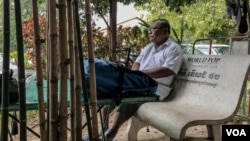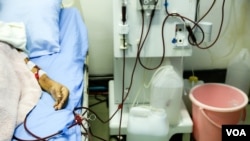In the corridors of Preah Ket Mealea Dialysis Center, where patients with end-stage kidney disease spend hours every day hooked up to blood-purifying machines, the whispered conversations between patients and their families make for grim listening.
There are no expressions of hope, as you might hear in other hospitals where patients stand a chance of getting better. The prognosis is dire for all but the wealthiest of Cambodia’s kidney patients. Many of them have sold all their belongings to pay for dialysis or blood-cleaning treatment, and have no hope of affording a transplant.
“What would you do if you died tomorrow?” one patient asked.
“The world is like this: When you have money you can live longer, and if not you die,” said another.
Some patients here refer to kidney disease as “the sell everything you have illness.”
Lan Sunnara, the 63-year-old wife of a kidney patient on dialysis at Preah Ket Mealea, said she was at the point of desperation.
“I have sold everything,” she said. “We have almost run out of money, and if doctors will not welcome us anymore after that, he will just die.”
Her story is no longer unusual. The number of Cambodians suffering from kidney disease is rising, even as the country’s health infrastructure is largely unprepared to handle their treatment.
It is still impossible to get a kidney transplant anywhere in the country, and there are only a handful of dialysis centers and fewer than a dozen kidney specialists, known as nephrologists.
Chan Sovandy, the vice president of the Cambodia Association of Nephrologists, which has just 11 members across the country, said the prevalence of kidney disease in Cambodia was rising at a “very fast rate,” largely because of increases in diabetes and high blood pressure, both of which can cause kidney problems.
“It is clearly increasing very fast now,” he said.
In 2017, there were about 600 patients in Cambodia undergoing dialysis, a 10 to 20 percent increase from 2016, according to Dr. Sovandy. But this is just a drop in the bucket of the estimated need.
An untold number of poor Cambodians in need of kidney treatment cannot afford treatment at all. Even more probably do not know that they have kidney disease, which has no symptoms until it is at a very advanced stage—which is why doctors often call it “the silent killer.”
A 2015 study conducted at a medical center in Phnom Penh tested nearly 1,000 Cambodian patients with no known history or symptoms of kidney disease and found that nearly a third had protein or blood in their urine, a serious warning sign of kidney problems. All in all, more than half showed at least one abnormality on a routine urine test.
The study’s author concluded, “A comprehensive community screening program for hypertension and kidney disease is urgently needed to prevent ESRD [end-stage renal disease] in Cambodia.”
A separate 2015 study estimated that as much as 40 percent of Cambodia’s diabetic population had impaired kidney function—nearly 100,000 people.
The authors wrote that these findings emphasized “the importance of screening programs in resource-poor countries like Cambodia that lack a healthcare system that could bear the significant financial burden of universal access to maintenance renal replacement therapy.”
“In such countries,” they added, “many of the individuals who present with late-stage CKD [chronic kidney disease] are likely to die from the consequences of kidney disease.”
The Pain of Dialysis, The Pain of No Dialysis
No such screening program appears to be on the horizon. This is especially problematic because Cambodians also have very poor access to renal replacement therapy or dialysis. (By contrast, in neighboring Thailand, which also has high rates of kidney disease, there is universal coverage of dialysis.)
Kidneys work to purify the blood and filter out toxins. When they are functioning poorly, patients can undergo dialysis, known in Khmer as “blood cleaning,” which artificially filters the blood by pumping it out of the body, purifying it, and pumping it back in again.
However, the process is expensive and time-consuming and has serious side effects, including fatigue and low blood pressure, and a raised risk of sepsis.
At the dialysis center at Preah Ket Mealea hospital in Phnom Penh, there are only 20 beds. Each patient must spend several hours hooked up to the machine, meaning that only around 60 patients can undergo dialysis every day. There are a similar number of beds at the nearby Chea Sim Hemodialysis Center and two other hospitals in Phnom Penh, as well as one each in Battambang, Siem Reap and Sihanoukville.
Kong Seat, 68, a retired schoolteacher from Kampot, said he had spent at least $100,000 over the past five years on treating his chronic kidney disease, which he developed due to hypertension and diabetes.
“If we have this disease, whether we have the money or not, we have to come here [the dialysis center] regularly as appointed. If we don’t come, it causes much pain,” he explained.
Seat spoke slowly as if exhausted. He lay sprawled on a bed at Preah Ket Mealea, watching his blood pumping out of a catheter in his leg and into the dialysis machine, where it was cleaned and then replaced.
His wife, Lan Sunnara, described their family as “once middle class.” Both she and her husband were sixth-grade teachers at a primary school in their hometown in Kampot province. They owned several plots of land and some trucks, which they used to run a small transport service.
But when Kong Seat got sick, that all changed. They had to leave their jobs, their house, and their youngest daughter in Kampot and rent a small room in a suburb of Phnom Penh so that he can receive dialysis three times a week. They sold their land and their vehicles.
This is a common experience for rural Cambodians with kidney disease. On top of the $600 monthly cost of dialysis, as well as paying for medications out of pocket, patients have to leave their homes and pay for accommodation in Phnom Penh with at least one caretaker, if not the whole family. The average wage in Cambodia is still just a bit above $100 a month.
Many of the regulars at Preah Ket Mealea spend hours talking to each other about their dire financial situations, Sunnara said.
“Everyone raises this issue. They say there should be a subsidy for people like us. It’s been five years and we have spent too much money. I have no more ideas. I’m mentally tired,” she said.
Transplants Out of Reach
The only cure for kidney disease is a transplant, in which a diseased kidney is swapped out for a healthy organ belonging to a donor. But this operation cannot be performed in Cambodia, nor are there any screening programs to match donors and recipients, making it out of reach for all but the mega-wealthy who can afford to fly to India, Thailand or Singapore.
Making matters more complicated, the government in 2016 banned payment for organs in a bid to quash organ trafficking. This made it nearly impossible for Cambodians to access a kidney transplant legally unless they can convince somebody to give one for free.
Several years ago, a group of military doctors working out of Preah Ket Mealea hospital, including two generals, were arrested for allegedly paying Cambodians for their kidneys, then transplanting them into sick Chinese patients at vastly inflated rates, under the supervision of Chinese doctors.
After the case received widespread publicity, police withdrew the charges, and the hospital released a statement claiming that the transplants were simply part of a Chinese program to train Cambodian surgeons.
However, four years later, there are still no Cambodian surgeons capable of performing the operation in the country, and there is no way for a Cambodian citizen to get a kidney transplant here.
“The only thing we can do is to save the patients by operating dialysis,” Dr. Sovandy said.
Veteran journalist Saing Soenthrith, who found out he had chronic kidney disease in 2016 after suffering from diabetes for years, had to quit his reporting job at The Cambodia Daily because his triweekly dialysis treatments were so time-consuming and made him exhausted.
“Before, I could drive myself to do dialysis and drive back home, but now I feel so weak,” he said, adding that he had endured over 200 blood-purifying sessions so far.
Soenthrith, a single father of three, has been trying for the past two years to save enough money to pay for a kidney transplant in India, which will require at least $40,000 up front. But without a job and with three children to support, this is a struggle. His last hope, he says, is that he will be able to sell a plot of land he had been hoping to retire on.
“I want to recover. I can’t bear doing dialysis anymore. If I can’t go to India this year, it will be over,” he said.
A Regional Public-Health Crisis
Kidney disease is one of the most significant public health problems in the region.
The annual mortality rate per 100,000 people from chronic kidney disease in Asia has increased by 77.9 percent since 1990, an average of 3.4 percent a year, according to the World Health Organization.
This is due largely to lifestyle changes caused by economic development, which can lead to what is known as “diseases of affluence.” These are chronic illnesses caused by unhealthy living, such as overeating and lack of physical activity. One of the leading causes of chronic kidney disease worldwide is hypertension, or high blood pressure, which can damage the tiny blood vessels that are crucial to the kidney’s functioning.
In turn, a damaged kidney can cause blood pressure to rise, creating a potentially disastrous situation if it is not treated. Many Cambodians still do not receive routine preventative care, making it harder here to catch kidney disease in its early stages than it is in developed countries.
Diabetes, an endocrine disorder whose prevalence is also rising in Cambodia, makes it hard for the body to process sugar. This can cause damage across a number of different organs, particularly the kidneys.
The healthcare NGO MoPoTsyo calls diabetes prevalence in Cambodia “surprisingly high” given the country’s poverty rate, estimating that it could be as high as 10 percent in some areas.
“These kinds of diseases are likely rising in a peaceful country, where people freely enjoy eating without thinking about how much oil, protein, or junk food they consume, which is harmful to the endocrine system,” said Dr. Sovandy.
Last year, Health Minister Mam Bunheng projected that over 600,000 Cambodians will have diabetes by 2025. But few of them are able to receive appropriate treatment, or even good nutritional advice, which is crucial for controlling the disease.
“Patients with diabetes don’t have access to proper treatment.” Dr. Sovandy said, “This includes having regular and proper medical treatment, and adapting to better lifestyle change.”
Dr. Sovandy said that the tiny number of nephrologists in Cambodia meant that serious research on kidney disease in the local context was not being carried out.
“Abroad, people are more critical about diet. That is why there should be in-depth studies on therapeutic diets [in Cambodia], which would be very important for our nephrologists, but there are no studies.”
“It all seems blurry right now,” he said.








